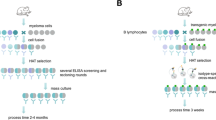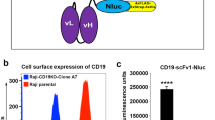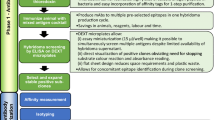Abstract
A normal antibody-producing cell only expresses one antibody, resulting in the well-known phenomenon of allelic exclusion. When two myeloma cells are fused, the derived hybrids are capable of co-dominantly expressing the antibody genes of both parents. Although the respective variable (V) and constant (C) region genes remain expressed in the same cis configuration, heavy and light chains of both parents are scrambled, and hybrid molecules are formed1–4. The same is true when a myeloma and an antibody-producing cell are fused to produce a hybrid myeloma (hybridoma)2,3. Fusion therefore allows the production of hybrid immunoglobulin molecules containing two different combining sites. Hybrid molecules of this type retain antigen-binding activity and specificity5,6. Bispecific monoclonal antibodies secreted by hybridomas may have a variety of uses in biology and in medicine. Here we have focused on their application in histochemistry. As an example, we have prepared and tested an anti-somatostatin–anti-peroxidase bi-specific antibody. This way of producing hybrid molecules is superior to the production of hybrid antibodies by chemical reconstitution methods7–9 because the drastic treatment required for chain separation in the latter is likely to lead to some protein denaturation and loss of antibody activity. Intracellularly synthesized and assembled hybrids do not suffer from this disadvantage. In addition, the recombination of heavy and light chains from different antibody molecules is likely to lead to considerable waste.
This is a preview of subscription content, access via your institution
Access options
Subscribe to this journal
Receive 51 print issues and online access
$199.00 per year
only $3.90 per issue
Buy this article
- Purchase on Springer Link
- Instant access to full article PDF
Prices may be subject to local taxes which are calculated during checkout
Similar content being viewed by others
References
Cotton, R. G. H. & Milstein, C. Nature 244, 42–43 (1979).
Köhler, G. & Milstein, C. Nature 256, 495–497 (1975).
Milstein, et al. Cold Spring Harb. Symp. quant. Biol. 41, 793–803 (1977).
Margulies, D. H., Kuehl, W. M. & Scharff, M. D. Cell 8, 405–415 (1976).
Howard, J. C., Butcher, G. W., Galfre, G., Milstein, C. & Milstein, C. P. Immun. Rev. 47, 139–173 (1979).
Martinis, J., Kull, J. F., Franz, G. & Bartholomew, R. M. Colloquium of the Protides of Biological Fluids Vol. XXX (ed. Peeters, H.) (Pergamon, Oxford, in the press).
Nisonoff, A. & Mandy, W. J. Nature 194, 355–359 (1962).
Hämmerling, U., Aoki, T., de Harven, E., Boyse, E. A. & Old, C. J. J. exp. Med. 128, 1461–1473 (1968).
Nisonoff, A., Hopper, J. E. & Spring, S. B. The Antibody Molecule (Academic, New York, 1975).
Galfre, G., Butcher, G. W., Howard, J. C., Wilde, C. D. & Milstein, C. Transplant Proc. 12, 371–376 (1980).
Galfre, G. & Milstein, C. Meth. Enzym. 73, 3–46 (1981).
Herzenberg, L. A. & Secher, D. S., quoted in Herzenberg, L. A. & Milstein, C. Handbook of Experimental Immunology (ed. Weir, D. M.) 25.1–25.7 (Blackwell, Oxford, 1978).
Zimmerman, B. & Grey, H. M. J. Immun. 107, 1788–1790 (1971).
Eden, A., Lamm, M. E. & Nussenzweig, V. J. Immun. 108, 1605–1608 (1972).
De Preval, C. & Fougereau, M. J. molec. Biol. 102, 657–678 (1976).
Hökfelt, T. et al. Acta endocr. Suppl. 200, 5–41 (1975).
Van Leeuwen, F. W., De Raay, C., Swaab, D. F. & Fisser, B. Cell Tissue Res. 202, 189–301 (1979).
Brazeau, P. et al. Science 179, 77–79 (1973).
Krisch, B. Cell Tissue Res. 195, 499–513 (1978).
Rorstad, Q. P., Epelbaum, J., Brazeau, P. & Martin, J. B. Endocrinology 105, 1083–1092 (1979).
Sternberger, L. A. Immunocytochemistry 2nd edn (Wiley, New York, 1979).
Sternberger, L. A., Hardy, P. H., Cuculis, J. J. & Meyer, H. G. J. Histochem. Cytochem. 18, 315–333 (1970).
Vandesande, F. in Immunohistochemistry (ed. Cuello, A. C.) (Wiley, Chichester, in the press).
Boorsma, D. M. in Immunohistochemistry (ed. Cuello, A. C.) (Wiley, Chichester, in the press).
Boorsma, D. M., Cuello, A. C. & Van Leeuwen, F. W. J. Histochem. Cytochem. 30, 1211–1216 (1982).
Priestley, J. V. & Cuello, A. C. in Inmmunohistochemistry (ed. Cuello, A. C.) (Wiley, Chichester, in the press).
Cuello, A. C., Priestley, J. V. & Milstein, C. Proc. natn. Acad. Sci. U.S.A. 79, 665–669 (1982).
Sofroniew, M. V., Madler, M., Müller, O. A. & Scriba, P. C. Z. analyt. Chem. 290, 163 (1978).
Cuello, A. C., Galfre, G. & Milstein, C. Proc. natn. Acad. Sci. U.S.A. 76, 3532–3536 (1978).
Galfre, G., Milstein, C. & Wright, B. Nature 277, 131–133 (1979).
Author information
Authors and Affiliations
Rights and permissions
About this article
Cite this article
Milstein, C., Cuello, A. Hybrid hybridomas and their use in immunohistochemistry. Nature 305, 537–540 (1983). https://doi.org/10.1038/305537a0
Received:
Accepted:
Issue Date:
DOI: https://doi.org/10.1038/305537a0
This article is cited by
-
Tuning the Assembly of Bispecific Antibodies by Playing on Differential Polypeptide Chain Molar Ratios
Biotechnology and Bioprocess Engineering (2023)
-
A new approach to produce IgG4-like bispecific antibodies
Scientific Reports (2021)
-
The renaissance of chemically generated bispecific antibodies
Nature Reviews Chemistry (2021)
-
A novel asymmetrical anti-HER2/CD3 bispecific antibody exhibits potent cytotoxicity for HER2-positive tumor cells
Journal of Experimental & Clinical Cancer Research (2019)
-
Bispecific antibodies: a mechanistic review of the pipeline
Nature Reviews Drug Discovery (2019)
Comments
By submitting a comment you agree to abide by our Terms and Community Guidelines. If you find something abusive or that does not comply with our terms or guidelines please flag it as inappropriate.



